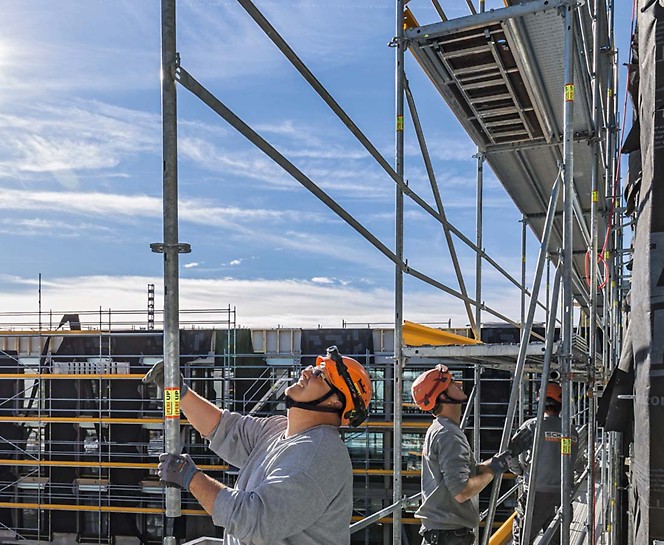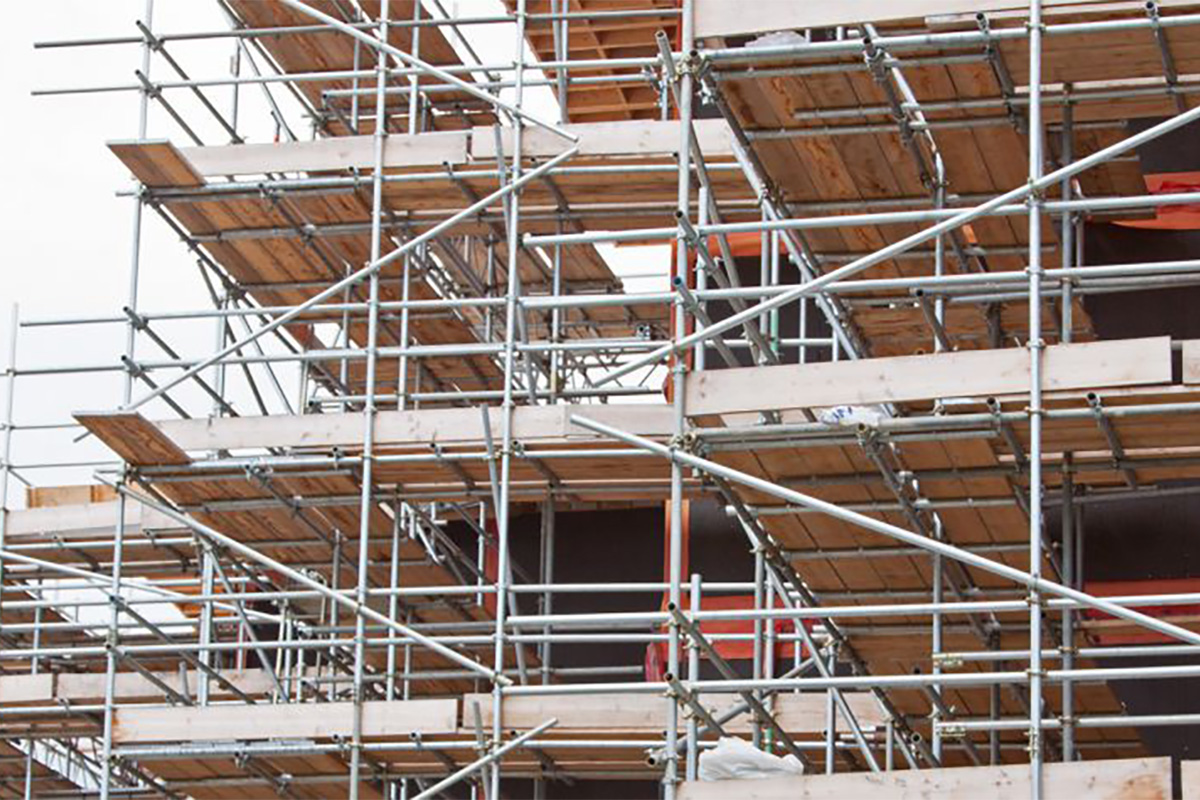Temporary Roof Scaffolding to Ensure Safe Working Conditions During Projects
Temporary Roof Scaffolding to Ensure Safe Working Conditions During Projects
Blog Article
Checking Out the Numerous Types of Scaffolding Utilized in Construction Tasks
The building and construction sector counts heavily on various kinds of scaffolding to fulfill certain project requirements, each offering distinctive benefits and applications. Standard structure scaffolding supplies a durable structure for general tasks, while suspended scaffolding is crucial for deal with high-rise structures. Various other choices, such as system and rolling scaffolding, provide to performance and movement, specifically. The cantilever variant verifies important in city atmospheres where space is constrained. Understanding the nuances of these scaffolding kinds is important for maximizing security and efficiency on building and construction websites, triggering a better examination of their one-of-a-kind features and applications.

Typical Framework Scaffolding
Traditional framework scaffolding is among one of the most widely made use of methods in the building sector as a result of its toughness and adaptability. This system is composed of vertical and horizontal structures that are constructed to produce a stable system for materials and employees. The major components consist of upright articles, straight journals, and diagonal braces, which together offer a solid structure that can sustain substantial loads.
Among the vital benefits of standard structure scaffolding is its versatility to various building jobs, varying from residential structures to large industrial frameworks. The modular style allows for very easy setting up and disassembly, making it effective for both long-lasting and temporary projects. Furthermore, the system can be tailored in elevation and size, accommodating various building styles and site conditions.
Safety is vital in scaffolding applications, and standard structure systems are furnished with guardrails and toe boards to avoid drops and ensure worker security. Routine assessments and adherence to safety regulations are crucial in keeping the integrity of the scaffold (Scaffolding). On the whole, standard framework scaffolding remains a basic choice in the construction market, giving a trustworthy platform for labor and enhancing total job efficiency

Suspended Scaffolding
Suspended scaffolding supplies an one-of-a-kind solution for building tasks that need access to elevated surface areas, particularly in circumstances where traditional frame scaffolding might be unwise. This kind of scaffolding is normally put on hold from the roof covering or upper degrees of a structure, utilizing a system of platforms, ropes, and pulley-blocks to create a functioning room that can be adjusted to numerous elevations.
One of the primary benefits of suspended scaffolding is its adaptability. It can be easily rearranged or decreased to accommodate modifications in building and construction requirements, making it ideal for tasks such as window installment, frontage work, and maintenance on skyscrapers. Furthermore, the very little footprint of put on hold scaffolding permits far better use of ground space in metropolitan environments, where space is commonly restricted.
Safety and security is a crucial factor to consider in making use of put on hold scaffolding. Proper rigging and securing systems should be used to make sure security and stop accidents. Operators must additionally be educated in the secure usage of this devices. On the whole, suspended scaffolding gives a effective and efficient service for accessing hard-to-reach locations in numerous construction scenarios, enhancing both performance and safety on website.
System Scaffolding
System scaffolding, often considered a contemporary solution in the scaffolding industry, contains pre-engineered components that can be promptly set up and adjusted for numerous construction tasks. Scaffolding. This kind of scaffolding is identified by its modular style, which enables versatility and effectiveness on task sites, fitting different elevations and architectural requirements
Commonly made from high-strength steel or light weight aluminum, system scaffolding supplies enhanced resilience and security. The components consist of upright posts, horizontal ledgers, and diagonal dental braces, which interconnect securely, making sure a robust framework. The design frequently includes standardized installations, simplifying assembly and disassembly processes, thereby minimizing labor time and expenses.

Rolling Scaffolding
Moving scaffolding is a versatile choice to traditional set scaffolding, designed for movement and ease of usage on construction sites. This kind of scaffolding includes Scaffolding Cobham a platform sustained by frames with wheels, permitting employees to easily transfer it as required. The wheelchair attribute substantially boosts productivity, as it reduces downtime connected with dismantling and constructing dealt with scaffolding.
Normally built from lightweight products such as light weight aluminum or steel, rolling scaffolding offers a sturdy yet portable remedy for projects needing constant repositioning - Scaffolding. It is specifically helpful in tasks such as painting, drywall installation, and electric work, where accessibility to different heights and locations is necessary
Security is extremely important in rolling scaffolding style, with features such as locking wheels to stop unintended activity when in usage, and guardrails to safeguard employees from falls. In addition, lots of designs are flexible in elevation, fitting different task requirements.
Cantilever Scaffolding

The layout of cantilever scaffolding commonly entails utilizing brackets or arms anchored to a building or framework, enabling the platform to prolong outside safely. Safety and security is extremely important; thus, these scaffolds should be crafted to hold up against different loads and ecological problems. Regular assessment and maintenance are important to ensure structural honesty and worker safety and security.
Cantilever scaffolding is preferred for its adaptability and efficient use area, making it a preferred selection in urban atmospheres where room constraints are typical. Furthermore, it assists in less complicated access to high altitudes, inevitably adding to the total efficiency of building and construction jobs. Just like all scaffolding kinds, correct training and adherence to security criteria are important for employees making use of cantilever scaffolding.
Verdict
To conclude, the varied kinds of scaffolding used in building and construction jobs each offer distinct functions tailored to specific website demands. Conventional frame scaffolding gives stability, while put on hold scaffolding offers adaptability for elevated jobs. System scaffolding promotes quick setting up, and rolling scaffolding improves flexibility for differing job environments. Cantilever scaffolding properly addresses challenges in metropolitan settings. Comprehending these scaffolding kinds is important for enhancing safety and productivity in building and construction, eventually contributing to the effective completion of projects.
Typical frame scaffolding offers a strong foundation for general jobs, while put on hold scaffolding is necessary for work on high-rise structures.Rolling scaffolding is a versatile alternative to conventional set scaffolding, created for flexibility and convenience of usage on construction websites. As with all scaffolding kinds, correct training and adherence to safety standards are important for employees utilizing cantilever scaffolding.
Typical structure scaffolding gives security, while suspended scaffolding provides convenience for raised tasks. System scaffolding helps with quick assembly, and rolling scaffolding boosts flexibility for varying work settings.
Report this page